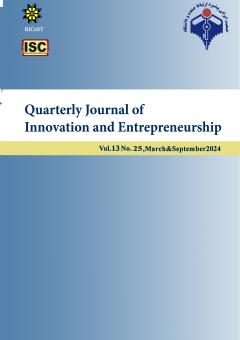A Model For Developing Policy Tools to Support Language Technologies in Cyber Space
Subject Areas : Special
Habibollah Asghari
1
![]() ,
Fatemeh Mostajer Kheirkhah
2
,
Fatemeh Mostajer Kheirkhah
2
![]()
1 - Assistant Professor, ICT Research Institute, ACECR, Tehran, Iran
2 - Assistant Professor, ICT Research Institute, ACECR, Tehran, Iran
Keywords: Natural Language Processing, Language Technologies, Persian Language Development, Policy Tools.,
Abstract :
Language technologies are one of the important components of national authority in the cyberspace, and its promotion are the main duties of governments. The importance of language technologies makes the role of government support policies in this field an undeniable necessity. These support policies are often explained and compiled with the aim of developing practical tools in various fields such as tourism, health, education or other public areas.
In this article, the innovative approaches adopted by governments to support language technologies and writing practices in cyberspace have been investigated. In this regard, the road map and documents have been published and the development methods of infrastructure tools and practical products in the field of script and language support in the countries of India, the United States of America, Wales, Spain, and the European Union have been examined and reviewed from different aspects. Finally, the achievements of this study have been used by examining the common points and the cases that have the ability to be implemented in the case of the Persian language to provide suitable solutions for developing a national strategic document in support of the Persian language
1. Cazden, C. B. (2003). Sustaining indigenous languages in cyberspace. Nurturing Native Languages, 2002(1). https://files.eric.ed.gov/fulltext/ED482034.pdf .
2. Cohen, J. (2007). The GALE project: A description and an update. Automatic Speech Recognition & Understanding. https://doi.org/10.1109/asru.2007.4430115.
3. COMM. (2013). LT2013 - status and potential of the European language technology markets - digital single market - European Commission. Retrieved June 4, 2016, https://economie.fgov.be/en/themes/online/strategy-european-digital/connecting-europe-facility-cef.
4. Diki-Kidiri M (2007), Securing a place for a language in cyberspace. Paris: UNESCO. Retrieved 4 June 2016, http://unesdoc.unesco.org/images/0014/001497/149786E.pdf.
5. European Commission. (2014). Horizon 2020 work programme for 2014-2015. European Commission Decision C (2015)2453 of 17 April 2015. Retrieved June 4, 2016, https://ec.europa.eu/research/participants/data/ref/h2020/wp/2014_2015/main/h2020-wp1415-security_en.pdf.
6. European Commission. (2015). Horizon 2020 work programme for 2016-2017. European Commission Decision C (2015)6776 of 13 October 2015. Retrieved June 4, 2016, https://ec.europa.eu/research/participants/data/ref/h2020/wp/2016_2017/main/h2020-wp1617-intro_en.pdf.
7. Kumar A., Goyal V. (2010) TDIL Programme: A Government Initiative, an International Journal of Engineering Sciences, 2010. https://ijoes.vidyapublications.com/paper/JSI/1.pdf
8. Olive, J. P., Christianson, C., & McCary, J. (2011). Handbook of Natural Language Processing and Machine Translation: DARPA Global Autonomous Language Exploitation. http://ci.nii.ac.jp/ncid/BB05333792
9. Ong, T. W. S., & Said, S. B. (2021). Selective language maintenance in multilingual Malaysia. In Advances in religious and cultural studies (ARCS) book series (pp. 207–228). https://doi.org/10.4018/978-1-7998-2959-1.ch009
10. Pedtke, T. R. (1997). U.S. Government Support and Use of Machine Translation: Current Status. ACL Anthology. https://aclanthology.org/1997.mtsummit-plenaries.1
11. United Nations. (n.d.). Protecting languages, preserving cultures | United Nations. https://www.un.org/en/desa/protecting-languages-preserving-cultures-0
12. Rehm, G., Berger, M., Elsholz, E., Hegele, S., Kintzel, F., Marheinecke, K., Piperidis, S., Deligiannis, M., Galanis, D., Gkirtzou, K., Labropoulou, P., Bontcheva, K., Jones, D. L., Roberts, I., Hajič, J., Hamrlová, J., Kačena, L., Choukri, K., Arranz, V., . . . Klejch, O. (2020). European Language Grid: An Overview. arXiv (Cornell University). http://arxiv.org/pdf/2003.13551.pdf
13. Sepln, (2015) Plan de Impulso de las Tecnologías del Lenguaje, Retrieved June 4, 2016, http://www.sepln.org/news/plan-de-impulso-de-las-tecnologias-del-lenguaje/
14. St. Clair, R. N. (2010, November 17). Review of Reyhner & Lockard (2009): Indigenous Language Revitalization: Encouragement, Guidance & Lessons Learned. Language Problems and Language Planning, 34(3), 267–269. https://doi.org/10.1075/lplp.34.3.05stc. Stiles, D. B. (1997). Four Successful Indigenous Language Programs. Teaching Indigenous Languages. https://eric.ed.gov/?id=ED415079
15. The Government of Spain promotes language as a factor for modernization and economic development, 2022, https://www.lamoncloa.gob.es/lang/en/gobierno/councilministers/Paginas/2022/20220301_council.aspx
16. Vikas, O. (2001). Language Technology Development in India. Ministry of Information Technology, New Delhi, India. http://www.emille.lancs.ac.uk/lesal/omvikas.pdf
17. Warschauer, M. (1998). Technology and Indigenous Language Revitalization: Analyzing the experience of Hawai’i. Canadian Modern Language Review-revue Canadienne Des Langues Vivantes, 55(1), 139–159. https://doi.org/10.3138/cmlr.55.1.139
18. Welsh language technology action plan, October 2018, https://www.gov.wales/sites/default/files/publications/2018-12/welsh-language-technology-and-digital-media-action-plan.pdf
19. Welsh language | GOV.WALES. (2024, February 20). GOV.WALES. http://gov.wales/topics/welshlanguage/?lang=en
20. White, R. M. (1993). Machine Translation Technology: A Potential Key to the Information Age. Report of the FCCSET Committee on Industry and Technology, PB-93-134336, Office of Science and Technology Policy, Washington, DC (January 1993).
21. اصغری، حبیب اله و محتاج، سالار، «سند ارتقاء خط و زبان فارسی در فضای مجازی»، معاونت علمی و فناوری ریاست جمهوری، ستاد توسعه فناوری اطلاعات و ارتباطات، فروردین ماه 1395.


